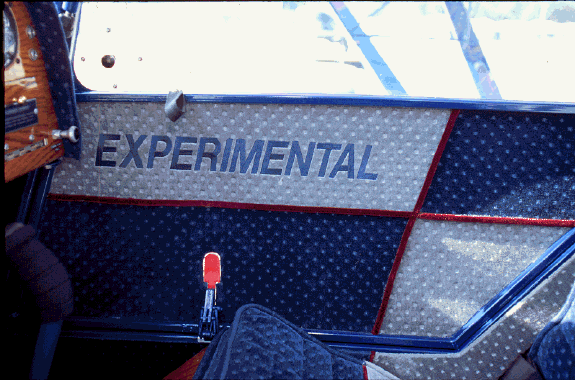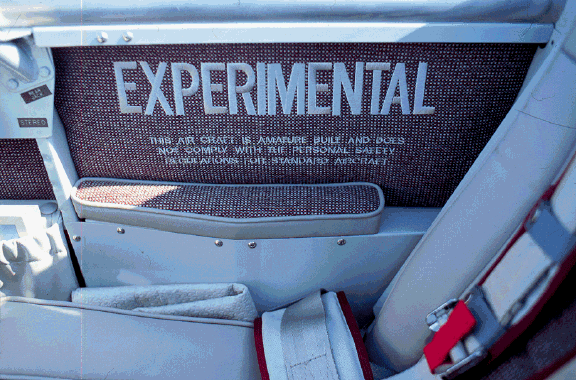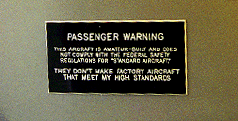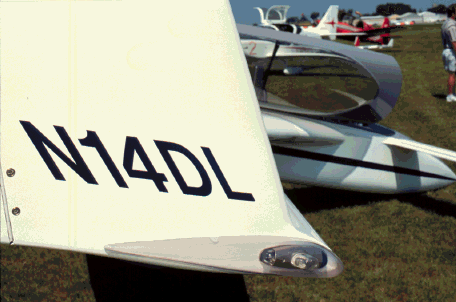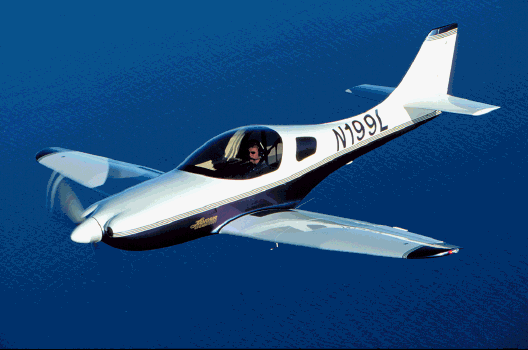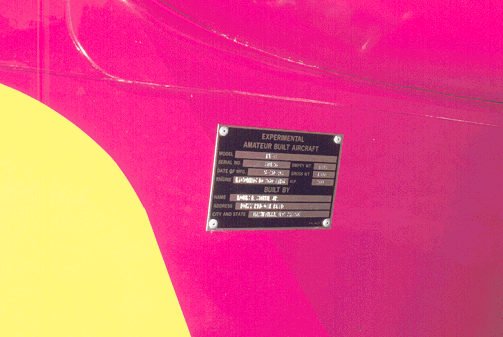Markings, Placards, Numbers: Don't forget these items
By Ron Alexander(originally published in EAA Sport Aviation, June 2000)
When you’re immersed in building and assembling the parts of your airplane, it’s easy to forget certain important items that you must complete before the FAA comes to inspect your work. And if you haven’t addressed these mandatory items, your final inspection will be short and will not bear the fruit-an airworthiness certificate. These items were included in the checklist covered in the May issue. Let’s review each one, along with the regulations that pertain to them.
Instrument and Control Markings
Your instruments should be properly marked appropriately to your airplane. For example, the airspeed indicator should denote your airplane’s never-exceed speed, and the engine instruments should have markings for maximum and minimum safe operation. Baggage compartments should be properly placarded with maximum weights, and you may want to put no-step markings in certain places, along with other warnings.
The FAA doesn’t provide a lot of guidance on instrument markings and other required placards. In Paragraph 128 section c(5), FAA Order 8130.2D (the airworthiness certification guide used by the FAA inspector) simply says that the builder will make the aircraft available for inspection and that, “The instruments are properly marked.” But Paragraph 134b(13) gives you another information source by saying, “This aircraft shall contain the placards, markings, etc. as required by FAR 91.9.”
Federal Aviation Regulation 91.9, “Civil Aircraft Flight Manual, Marking, and Placard Requirements,” applies to amateur-built aircraft, and it says that “...no person may operate a civil aircraft without complying with the operating limitations specified in the approved Airplane or Rotorcraft Flight Manual, markings, and placards, or as otherwise prescribed by the certificating authority of the country of registry.” In (b)(2) it says that you may not operate your aircraft “...unless there is available in the aircraft a current approved Airplane or Rotorcraft Flight Manual, approved manual material, markings, and placards, or any combination thereof.”
In short, you must have a way to know the airplane’s restrictions so you can avoid exceeding them, and you must have a way to avoid exceeding the limitations of the aircraft, engine, propeller, etc. The required markings, placards, or a flight manual clearly state these limits.
FAA Order 8130.2D says in Paragraph 134b(23) that a homebuilt’s condition (annual) inspection shall be conducted in accordance with FAR Part 43 Appendix D. In this appendix, item c(4) states that you must inspect “instruments for poor condition, mounting, markings, and (where practical) improper operation.”
Another FAA source that states the requirement for instrument markings is the sample Operating Limitations in Advisory Circular 20-27D, Certification and Operation of Amateur-Built Aircraft. It says, “This aircraft shall contain the placards, markings, etc., required by FAR section 91.31 (new FAR section 91.9).”
Where do you find guidelines on what instruments to mark and how to mark them? The designer or kit manufacturer should provide most of this information. Some markings are obvious-such as the never-exceed speed of the airframe, the flap speeds, maximum oil temperature, etc. FAA Advisory Circular 20-88A, Guidelines on the Marking of Aircraft Powerplant Instruments (Displays), provides additional guidance for proper markings. This AC talks about proper colors to use and their respective size. It also talks about specific instrument markings (see Instruments to Mark on page 35).
Emergency Locator Transmitter
Does an amateur-built aircraft need an ELT? The short answer is yes. Homebuilts operate under FAR Part 91, and FAR 91.207 governs emergency locator transmitters. If your airplane carries more than one person, it must have an ELT. This requirement takes effect after you have test-flown your aircraft. FAR 91.207(f)(4) excludes aircraft engaged in flight operations incident to design and testing. But once you have flown your prescribed test hours and are released from your test area, you need an ELT.
Even though you don’t need an ELT during your test period, I’d suggest that you install one before your FAA inspection. Perhaps more important than meeting the post-testing requirement, it’s easier to install the ELT bracket while you’re building rather than after. The regulations don’t prescribe a precise installation location; they simply say that you should install it where the probability of damage to the actual transmitter in the event of an accident is minimized. This usually means somewhere in the aft part of the fuselage, but don’t bury it so that changing the batteries is difficult.
Again, if you’re building a single-seat airplane, you don’t need an ELT-but installing one anyway is good for your own protection, especially if you fly over unfriendly terrain. Modern techniques have certainly improved the search efforts that are initiated by an ELT transmission. Why not take advantage of this cheap insurance?
After you install an ELT, remember to follow the regulations covering its batteries. When you receive the ELT, it should have an expiration date for the batteries. This date must be legibly marked on the outside of the transmitter itself and you should enter that date in the airframe logbook. Whenever you change the batteries, you will note such in the logbook along with the new expiration date. You will also ensure the outside of the transmitter has the same marking.
|
|
|
|
|
Two examples of an elegant solution to a regulation: embroidering the required two-inch tall letters, EXPERIMENTAL, into the aircraft’s upholstery. |
Experimental Placard
On all amateur-built aircraft you’ll see a placard or lettering that says EXPERIMENTAL. The location of this word varies, but FAR 45.23(b) says it must be displayed near the entrance to the cockpit or cabin in letters that are not less than two inches or more than six inches high. This requirements also applies to aircraft with limited, restricted, and provisional airworthiness.
Where you locate EXPERIMENTAL depends on the airplane you are building and the FAA inspector’s interpretation of “near the entrance to the cockpit or cabin.” The regulation’s intent is to inform all who fly in the airplane that it was constructed by an amateur builder and is not a production airplane that complies with FAR Part 23 (Airworthiness Standards: Normal, Utility, Acrobatic, and Commuter Category Airplanes).
If you have one entrance to the cockpit (such as a canopy), only one side needs to be placarded. Many put EXPERIMENTAL inside the cockpit in a place where it’s visible upon entering. Other builders put the word on both sides of the aircraft. If you are in doubt where to place the word on your airplane, call the FAA inspector or DAR working with you for his or her advice. The word itself can be a decal, individual stick-on letters, painted on with a stencil, etc.
|
|
|
While it may not instill confidence in passengers, the passenger warning placard is nevertheless required by the FARs. |
Passenger Warning Placard
The EXPERIMENTAL placard isn’t enough to warn pilots and passengers that they aren’t in a production airplane. The FAA also requires a passenger warning placard. Section 13 of AC 20-27D refers to the FAA inspection and subsequent issuance of the airworthiness certificate. It says, “The applicant should expect the FAA inspector or DAR to verify that all required markings are properly applied, including the following placard which must be displayed in the cabin or the cockpit at a location in full view of all passengers. (Placard not applicable to single-place aircraft.)
“Passenger Warning-This aircraft is amateur-built and does not comply with the federal safety regulations for standard aircraft”
Briefly, the placard warns any prospective passenger that the airplane has not been manufactured to approved standards and may or may not be safe in which to ride. And don’t forget FAR 91.319, which requires pilots to advise passengers that the airplane is experimental.
|
|
|
|
|
The ultimate size of your aircraft’s N-number will depend on several factors including cruise speed and whether or not you’ll be flying outside the continental United States. |
N-Number
You must have a registration number on your aircraft, and FAR 45.21 gives the requirements:
“(a) Except as provided in §45.22, no person may operate a U.S.-registered aircraft unless that aircraft displays nationality and registration marks in accordance with the requirements of this section and §§45.23 through 45.33.
(b) Unless otherwise authorized by the Administrator, no person may place on any aircraft a design, mark, or symbol that modifies or confuses the nationality and registration marks.
(c) Aircraft nationality and registration marks must-
(1) Except as provided in paragraph (d) of this section, be painted on the aircraft or affixed by any other means insuring a similar degree of permanence;
(2) Have no ornamentation;
(3) Contrast in color with the background; and
(4) Be legible.”
When applying for the airplane’s registration number, you can request a personalized N-number. If you follow the requirements set forth in FAR 47.15 and the number isn’t already assigned to another airplane, you’re in business. The basic guidelines are that no more than five symbols may follow the letter N. The symbols may be all numbers, up to four numbers and a suffix letter, or up to three numbers and two suffix letters. You can’t use the letters I and O, and another number must precede the number 0.
To obtain a specific N-number, send the FAA an Affidavit of Ownership for Amateur-Built Aircraft, Form 8050-88, along with the number you desire (it’s best to give several numbers in order of preference, to save time if your first choice has already been assigned). If your aircraft is a kit, you must also send an Aircraft Bill of Sale, Form 8050-2, with the word “aircraft” crossed out and the word “kit” inserted in its place.
After the FAA has received your request and if the number you requested is not in use, you will receive a form letter assigning the N-number and a blank Form 8050-1, which is an Aircraft Registration Application. Fill out and return this form (with your N-number) to the Aircraft Registry. The form’s pink copy serves as your registration document until you receive the permanent Form 8050-3. You must register your airplane before the FAA inspector or DAR can issue your airworthiness certificate. I recommend that you allow at least 90 days for this entire process.
Once assigned an N-number, you must apply it to your airplane before the FAA inspection. FAR 45.23, 45.25, and 45.29 give the requirements for these markings. In short, you must permanently attach your number on both sides of the vertical tail or fuselage between the trailing edge of the wing and the leading edge of the horizontal stabilizer. If your airplane has twin tails, the N-number must appear on both outside surfaces.
If your airplane’s maximum cruise speed does not exceed 180 knots, you may use three-inch-high numbers and letters. If your maximum cruise speed exceeds 180 knots, you must use 12-inch symbols. If you’re building an aircraft that has the same external configuration as an aircraft built at least 30 years ago, you may use two-inch-high markings on each side of the vertical tail surfaces or fuselage.
If you want to fly your airplane outside of the continental United States, other variables come into play. In short, you’ll need 12-inch symbols to penetrate the Air Defense Identification Zone (ADIZ) that surrounds the United States. FAR 45.29(h) states, “After March 7, 1988, each operator of an aircraft penetrating an ADIZ or DEWIZ shall display on that aircraft temporary or permanent nationality and registration marks at least 12 inches high.” Note the word “temporary.” If your airplane normally requires two-inch or three-inch letters, you can legally attach temporary 12-inch letters for flights through the ADIZ.
|
|
|
According to the FARs, “...the aircraft identification plate must be secured to the aircraft fuselage exterior so that it is legible to a person on the ground, and must be either adjacent to and aft of the rearmost entrance door or on the fuselage surface near the tail surfaces.” |
Identification Plate
In addition to the N-number, you must also place an identification plate on the exterior of your experimental airplane. FAR 45.11 says,“(a) Aircraft and aircraft engines. Aircraft covered under §21.182 of this chapter must be identified, and each person who manufacturers an aircraft engine under a type or production certificate shall identify that engine by means of a fireproof plate that has the information specified in §45.13 of this part marked on it by etching, stamping, engraving, or other approved method of fireproof marking. The identification plate for aircraft must be secured in such a manner that it will not likely be defaced or removed during normal service, or lost or destroyed in an accident. Except as provided in paragraphs (c) and (d) of this section, the aircraft identification plate must be secured to the aircraft fuselage exterior so that it is legible to a person on the ground, and must be either adjacent to and aft of the rearmost entrance door or on the fuselage surface near the tail surfaces.”
This plate must contain the builder’s (your) name, the model designation, and the builder’s serial number. You can have your choice of numbers for the serial number as long as it is not being used by another similar type airplane. This is a major requirement for certification. This requirement also exists for an engine. If you mount a production (certificated) engine on your airplane, do not remove the engine’s data plate. Even though the engine becomes experimental when placed on an amateur-built airplane, you should leave the data plate in place.
Retaining the engine’s data plate serves another purpose. Paragraph 133c(1) of FAA Order 8130.2D states: “Amateur-built aircraft issued original airworthiness certificates should be limited to operation within an assigned test flight area for a minimum of 25 hours when a type certificated engine/propeller combination is installed, or a minimum of 40 hours when a non-type certificated engine/propeller is installed.” The data plate designates a type certificated engine/propeller combination, and with airworthiness directives complied with, it will reduce your flight test hours. (We’ll start discussing engine selection and installation next month.)
Builders need to complete all the preceding items before the FAA inspection. Make sure they are on your building schedule and checklist, and don’t wait until the last minute, especially with the paperwork items like getting an N-number. It can take some time, especially if you’re applying for a personalized N-number, and the FAA can’t inspect-and you can’t fly-the airplane until this, and all the other items are addressed.
Instruments to Mark
When preparing to mark your instruments, here’s a list to get you started. This is a partial list. You’ll need to establish what applies to your aircraft. When marking instruments, for a neater, more pleasing panel, think about having an instrument shop add the markings to the instruments’ faces.
- Airspeed indicator-never- exceed speed, flap speeds, etc.
- Oil temperature gauge-maximum oil temperature
- Oil pressure gauge-minimum oil pressure
- Cylinder head temperature-maximum allowable
- Throttle-mark the throttle operation
- Manifold pressure limits
- Tachometer-mark maximum and any restrictions
- Fuel pressure limits
- Flap lever or switch-mark
- Gear lever or switch-mark
- Carburetor heat control
- Alternate air source
- Mixture control
- Propeller control
